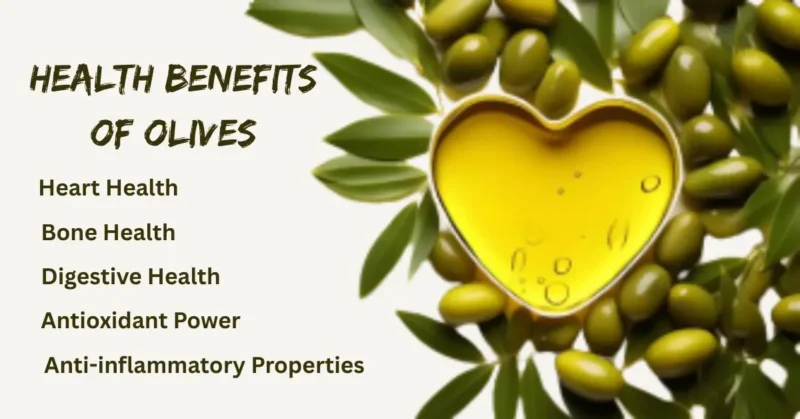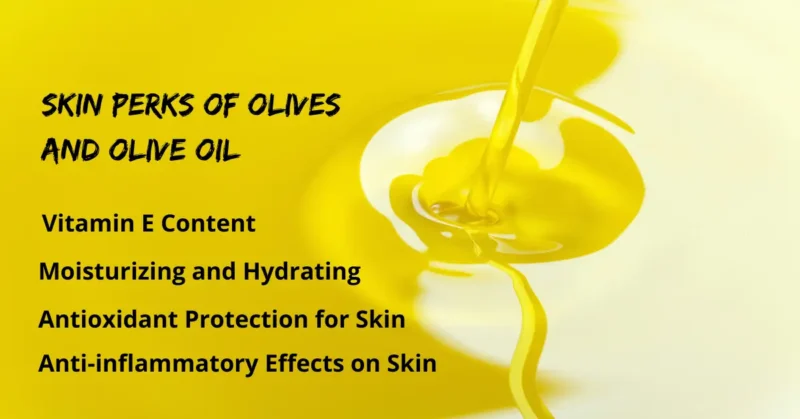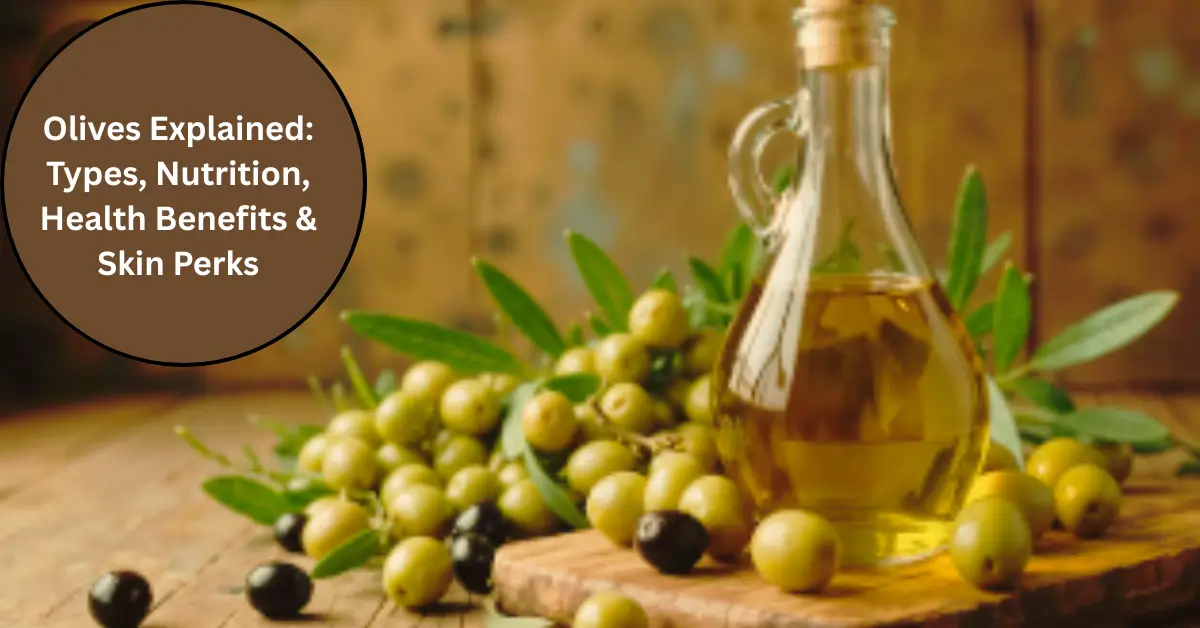Learn about the many types of olives, their rich nutrition profile, and the health and skin benefits they offer. Find out how to enjoy olives for wellness inside and out.
Thank you for reading this post, don't forget to subscribe!Olives are more than just a delicious garnish. Packed with healthy fats, antioxidants, and essential nutrients, they support overall wellness from the inside out. Olives offer daily health benefits, ranging from improved heart health to skin rejuvenation.
How can olives boost your health, improve skin, and add rich flavor to your diet while offering essential nutrients?
What exactly are olives? Often found on pizza, in salads, or as a tasty snack, olives are small, oval-shaped fruits with a hard pit inside and a distinct bitter flesh. While many think of them as vegetables, botanically speaking, they are indeed fruits, specifically a type of drupe, much like peaches or cherries.
Originating in the Mediterranean region thousands of years ago, olives have a long and illustrious history. Their cultivation became a mainstay of Mediterranean food and culture as it expanded over countries like Greece, Italy, and Spain.
Essential locations, like the biblical Mount of Olives, emphasize their deep religious and historical significance.
Olive trees, which are evergreen and flourish in arid, sunny areas, are the plants that bear olives. Flowers give rise to fruits, which are initially green before progressively changing color as they ripen. Their ultimate flavor, texture, and color are greatly influenced by how they are picked and prepared.
This article will take you on a tour through the varied world of olives, examining their various varieties, comprehending their extraordinary nutritional profile, learning about their amazing health advantages, and even studying how they can help your skin.
What is the number of varieties of olives?
Olives come in hundreds of varieties worldwide — over 1,000 named cultivars — but they are generally grouped by type, flavor, and use rather than an exact universal list.

Here’s the breakdown:
1. By Ripeness & Color
- Green Olives – Picked before full ripeness, firmer texture, tangy flavor.
- Black Olives – Fully ripened on the tree, softer, milder, sweeter taste.
- Purple/Brown Olives – Picked at mid-ripeness, balanced flavor.
2. By Use
- Table Olives – Processed for eating (e.g., Manzanilla, Kalamata, Castelvetrano).
- Oil Olives – High oil content, grown mainly for olive oil (e.g., Picual, Koroneiki, Arbequina).
- Dual-Purpose Olives – Suitable for both oil and table use (e.g., Frantoio, Leccino).
3. By Famous Varieties (Examples)
- Spain – Manzanilla, Arbequina, Hojiblanca, Picual
- Italy – Frantoio, Leccino, Taggiasca, Nocellara
- Greece – Kalamata, Amfissa, Halkidiki
- France – Picholine, Lucques, Nyons
- Turkey – Gemlik, Ayvalık, Memecik
- California (USA) – Mission, Sevillano
In short, over 1,000 named olive types exist, but they all fall into green, black, or intermediate categories and are chosen based on eating vs. oil-making.
Here’s a comprehensive table of 30 popular olive varieties from around the world with their origin, color, flavor profile, and primary use.
| Olive Variety | Origin | Color (Ripeness) | Flavor Profile | Primary Use |
|---|---|---|---|---|
| Manzanilla | Spain | Green | Briny, nutty, slightly bitter | Table |
| Arbequina | Spain | Brown to black | Mild, buttery, fruity | Oil & Table |
| Hojiblanca | Spain | Green to purple | Sweet start, peppery finish | Oil & Table |
| Picual | Spain | Green to black | Robust, peppery, high antioxidants | Oil |
| Kalamata | Greece | Dark purple | Rich, tangy, wine-like | Table |
| Amfissa | Greece | Green to black | Mild, fruity, smooth | Table |
| Halkidiki | Greece | Large green | Firm, slightly tart | Table |
| Koroneiki | Greece | Small green | Strong, grassy, peppery | Oil |
| Frantoio | Italy | Green to purple | Fruity, herbal, well-balanced | Oil & Table |
| Leccino | Italy | Dark brown | Mild, floral, delicate | Oil |
| Taggiasca | Italy | Dark purple | Sweet, almond-like, mild saltiness | Table |
| Nocellara del Belice | Italy | Bright green | Buttery, nutty, crisp texture | Table & Oil |
| Picholine | France | Green | Crunchy, tart, slightly salty | Table |
| Lucques | France | Green | Sweet, meaty, no bitterness | Table |
| Nyons | France | Wrinkled black | Sweet, mild, earthy | Table |
| Gemlik | Turkey | Black | Dense flesh, high oil content | Table & Oil |
| Memecik | Turkey | Green to purple | Rich, grassy, slightly bitter | Oil |
| Ayvalık | Turkey | Green to black | Smooth, fruity, buttery | Oil |
| Mission | USA (California) | Black | Mild, slightly smoky | Table |
| Sevillano | USA (California) | Green | Large, meaty, mild taste | Table |
| Gaeta | Italy | Wrinkled black | Sweet, winey, slightly tangy | Table |
| Verdial | Spain | Green | Mild, slightly sweet | Oil & Table |
| Castelvetrano | Italy | Bright green | Mild, buttery, crisp | Table |
| Alfonso | Chile | Purple-black | Tangy, wine-like | Table |
| Bella di Cerignola | Italy | Large green/red/black | Mild, fruity, firm texture | Table |
| Royal | Spain | Purple-black | Fruity, sweet | Table |
| Beldi | Morocco | Wrinkled black | Intense, fruity, slightly bitter | Table |
| Empeltre | Spain | Black | Sweet, nutty | Oil & Table |
| Gordal | Spain | Large green | Crunchy, mild, low bitterness | Table |
| Barnea | Israel | Green to black | Mild, smooth, buttery | Oil & Table |
Common Types of Olives
Olives are incredibly diverse, with thousands of varieties grown worldwide. They are typically categorized by their color when harvested and the processing methods used.

Green Olives
What are green olives? These olives were picked before they reached their peak ripeness. In comparison to black olives, they are renowned for having a hard texture and a flavor that is typically more bitter and occasionally pungent.
Green olives often go through a lye-based curing procedure and brine fermentation to become edible. Popular varieties include Manzanilla from Spain, known for its mild, almond-like flavor; Picholine from France, which is slender and nutty; and Cerignola from Italy, large and mild.
The vibrant, buttery Castelvetrano olive from Sicily is a well-loved green olive, famous for its mild, sweet flavor and crisp texture.
Black Olives
What are black olives? Compared to green olives, black olives have a milder, fruitier flavor and a softer texture. Its deep purplish-black color is a result of the tree’s natural ripening process.
Some black olives—often called “fat olives” because of their size—cure naturally, while others undergo air and brine processing to produce a consistent dark color and a softer flavor.
Greece’s Kalamata olives, which are distinguished by their almond-like form and rich, fruity taste, are among the most well-known black olives. Other popular types are French Nicoise, Californian Mission, and Italian Gaeta.
Greece is a major producer and consumer of olives; hence, many types, including Kalamata, are frequently referred to as “Greek olives” in general.
Other Notable Types/Preparations
Olives come in many varieties and preparations:
- Oil-cured olives: They have a strong flavor and shriveled appearance after being cured in oil.
- Salt-cured olives: Cured with dry salt, these olives are very salty and have a wrinkly texture.
- Cracked olives: These olives have been cracked physically to allow the cure brine to penetrate quickly, resulting in a distinct texture and flavor.
Nutritional Profile of Olives
Olive nutrition is impressive, making them a healthy addition to almost any diet. But are olives healthy, and specifically, are black olives good for you? The answer is a resounding yes! Black and green olives are rich in health-promoting substances.
- Macronutrients: Olives are renowned for their healthy fats, primarily monounsaturated fatty acids (MUFAs), with oleic acid being the most abundant. The heart benefits greatly from these lipids. Olives are relatively low in carbohydrates, contain a good amount of dietary fiber, and provide a small amount of plant-based protein.
- Micronutrients: They are a good source of several essential vitamins and minerals. Vitamin E is a potent antioxidant, and vitamin K is necessary for blood coagulation and bone health. Olives also provide minerals like iron (especially in black olives), calcium, and copper. Vitamin K is essential for bone health and blood coagulation, and Vitamin E is a potent antioxidant.
- Antioxidants and Phytochemicals: One of the most remarkable aspects of olives is their high concentration of antioxidants and beneficial phytochemicals. These include polyphenols like oleuropein and hydroxytyrosol, which are responsible for many of the health benefits. Flavonoids are another class of antioxidants present. Black olives, being riper, often contain a higher concentration of certain antioxidants compared to green olives, making them particularly beneficial.
Health Benefits of Olives

The rich nutritional profile of olives translates into a wide array of health benefits. What are the health benefits of olives?
- Heart Health: It is commonly recognized that the monounsaturated fats found in olives are suitable for the heart. They help to reduce “bad” low-density lipoprotein (LDL) cholesterol while potentially increasing “good” high-density lipoprotein (HDL) cholesterol. Additionally, some compounds in olives can contribute to blood pressure regulation, further protecting your heart.
- Anti-inflammatory Properties: Olives contain a unique compound called oleocanthal, which has potent natural anti-inflammatory effects similar to ibuprofen. It makes olives and olive oil potentially beneficial for managing chronic inflammatory conditions like arthritis.
- Antioxidant Power: Thanks to their abundance of polyphenols and other antioxidants, olives are excellent at protecting the body against oxidative stress. Chronic diseases can result from this stress, which is brought on by free radicals, damaging DNA and cells. By neutralizing free radicals, olives play a role in preventing conditions such as certain cancers and neurodegenerative diseases.
- Digestive Health: The fiber content in olives supports a healthy digestive system, aiding in regular bowel movements. Furthermore, some research suggests that the compounds in olives may help promote a healthy balance of gut bacteria, which is crucial for overall well-being.
- Bone Health: Emerging research indicates that polyphenols found in olives might offer potential benefits for bone density, suggesting a protective role against bone loss and conditions like osteoporosis.
Skin Perks of Olives and Olive Oil

Beyond internal health, olives and their oil offer fantastic benefits for skin. What are the benefits for skin?
- Moisturizing and Hydrating: Olive oil helps to soften and moisturize the skin because it is a natural emollient. It is an excellent ingredient in skincare products because of its rich fatty acid structure, which deeply hydrates dry and flaky skin.
- Antioxidant Protection for Skin: Just as they protect internal cells, the antioxidants in olives and olive oil, particularly Vitamin E and polyphenols, combat free radical damage on the skin. This protection helps fight against early aging symptoms like wrinkles and fine lines, as well as environmental stresses like pollution and UV rays.
- Anti-inflammatory Effects on Skin: The anti-inflammatory compounds found in olives can help to soothe irritated and inflamed skin. Olive oil is therefore a mild choice for anyone with skin disorders, including psoriasis, eczema, or overall redness.
- Vitamin E Content: The presence of Vitamin E is crucial for skin health. It enhances general skin suppleness, encourages the regeneration of healthy skin cells, and supports the skin’s natural repair processes, all of which help to create a smoother, younger-looking complexion.
The Bottom Line
Olives are a nutritional powerhouse with a long history and a wealth of health-promoting ingredients, making them much more than just a tasty snack. Olives have many advantages, from their varied varieties—from the sturdy Kalamata to the buttery Castelvetrano—to their remarkable nutritional profile, which is full of vitamins, antioxidants, and good fats.
You can improve your heart health, lower inflammation, strengthen your antioxidant defenses, aid in digestion, and even build stronger bones by using olives and high-quality olive oil in your regular diet.
Additionally, their topical Use and inclusion in skincare products can result in skin that is healthier and more vibrant. Embrace the versatility and value of olives to enrich both your plate and your well-being.
Read more Health and Wellness Tips.
You might love:

